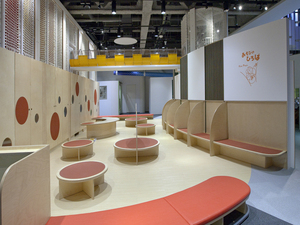Nagoya City Science Museum
TOP > Exhibition Guide > Floor Map> Wooden Playground
Wooden Playground



Purpose of Exhibition
We believe that children can be guided and introduced to the fun of science through observing toys in motion and their structure, and developing ideas by playing and by using their hands.
Additional Knowledge
In this corner, we get children to play with wooden toys. In order for them to play carefully, they must take off their shoes, sit on the floor, and play. Besides this, to avoid mixing with other toys and so that they concentrate on playing with their own toys, a separator plate is attached to the table creating a barrier with the next seat.
We decided to build this corner, considering how children are exposed to the latest experiences using science. We thought that as an initial entry point to science, it would be a wonderful experience for them to have the chance to play with wooden toys.
There are various kinds of toys, and in this corner we have placed pieces that can create new objects when put together with other pieces.
This is a typical example of a building block, a type of toy called construction blocks. While piling the blocks, thinking of creating some kind of shape, by the time the shape is assembled, new ideas are born and the already assembled structure is broken and begun again. This repetition shows that new ideas come not only from the head, but also from the hands. This is to say that thinking with your hands is also very important, as well as the hand movements.
As well as building blocks, there are toys which move. However, they don't use electricity or a motor. They move by the hand, and we consider it important that children realize how much the toys move with how much power.
Also there are toys equipped with wheels. The motion of the wheels can be transmitted to other movements by the cam (a cam is a rotating or sliding piece in a mechanical linkage). Children can confirm with their eyes and think about why they have such motions by deconstructing them. Furthermore, it is possible to replace parts, and make different motions. Therefore, children can discover new things by themselves.
Article by Yoshitaka Yamada, curator
